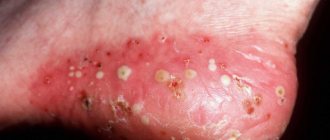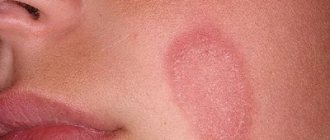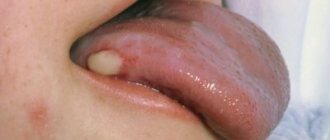Rubella disease in adults
Rubella belongs to the Togavirus family. Transmission occurs through airborne droplets exclusively from an infected person. Transplacental transmission during pregnancy is also possible. The virus is unstable in the environment and quickly dies when exposed to ultraviolet radiation.
Despite the fact that the pathology belongs to the category of children, adults can still become infected. Moreover, in this case, the disease passes with complications, causing intense signs of manifestation and a significant deterioration in the patient’s well-being. The disease poses a particular danger to women during pregnancy.
After contact with an infected person, the disease makes itself felt after 2–3 weeks, and the first symptoms resemble a common acute respiratory infection.
An infected person begins to spread pathological microorganisms already from the 5th day of the incubation period.
During the autumn-winter period, the body's protective functions are most susceptible to various pathologies. Therefore, this is the time when the greatest number of requests for medical help from patients with rubella symptoms occurs.
Adults encounter the rubella virus much less often than children, but the disease is severe and has complications.
Symptoms of rubella in adults
The rubella virus can appear in an atypical (erased) or manifest form. The first is characterized by a mild course of the disease, without severe symptoms. With a typical infection, signs of the virus of varying severity are observed.
In adults, the following symptoms of rubella infection appear:
- Temperature increase. Fever appears in the first days of the disease. The patient's health deteriorates as if he were suffering from an acute respiratory disease. In some cases, the temperature reaches 40°, and it is quite difficult to bring it down in adults.
- Enlarged lymph nodes. The symptom is typical for the first day of the pathology. The process of inflammation can affect any group of lymph nodes (axillary, inguinal), doctors have not established a clear sequence.
- Rash on the skin. This is the main sign of rubella, by which an experienced specialist can distinguish it from ailments with similar clinical manifestations. If in children the rashes appear in the form of red dots, then adults suffer from whole spots that merge to form erythema. The lesion begins from the behind-the-ear region, gradually covering the lower and upper limbs, back, and buttocks. In almost every case it occurs on the inner surface of the cheeks, the mucous membrane of the palate. In adults, the rash lasts longer than in children and begins to go away only after 5–7 days.
- Headache. With rubella, migraine cannot be eliminated with the help of medications and annoys the patient during the first days of the disease. The symptom significantly worsens your health.
- Painful sensations in muscles and joints. The symptom occurs at the beginning of the disease and resembles the condition of the flu. Therefore, it is difficult to diagnose rubella in the first days without consulting a doctor.
- Tearing. Another special symptom of rubella in adults. Discomfort occurs in daylight and artificial lighting. The patient feels better in a room with dim light.
- Conjunctivitis. Discharge of pus begins 3-4 days after the onset of the disease, usually at night. In the morning the patient can hardly open his eyes.
- Sore throat, runny nose, cough. This “bouquet” is typical for ARVI, but with rubella in an adult it manifests itself to the fullest.
Rubella in adults is characterized by a clear manifestation of symptoms, in contrast to the clinical picture of the disease in childhood.
Prevalence
Rubella is an acute infectious disease of viral etiology. Rubella is considered a benign infection and is usually mild, affecting mainly young people or children.
However, rubella is one of the most serious diseases for pregnant women, since in case of illness it leads to the development of congenital malformations of the fetus, which are combined into the “classic congenital rubella syndrome.”
Rubella is a contagious disease that, according to WHO, infects from 40 to 90% of non-immune (unvaccinated) contacts, depending on the activity of the immune system. The virus is transmitted by coughing, sneezing and breathing. This route of transmission is called airborne. The carrier is only a person. The virus is extremely unstable in the external environment and spreads mainly in close communities and groups.
Another piece of good news is that at the beginning of 2022, the World Health Organization issued an official certificate to the Ministry of Health of the Russian Federation for the complete eradication of rubella in the Russian Federation. This is recognition of the great preventive and educational work carried out regarding infectious diseases in our country.
Medicines
Photo: playbuzz.com
As is known, there is no etiotropic treatment; medications are prescribed to eliminate or alleviate the symptoms of the disease.
For a runny nose, vasoconstrictor nasal drops are used. Currently, the pharmacological market provides a lot of different drugs of this group, created for use among both adults and children. When vasoconstrictor drops enter the nasal mucosa, a spasm of the blood vessels located in it occurs. This leads to a reduction in swelling of the mucous membrane, which helps eliminate nasal congestion, reduce nasal secretion and improve nasal breathing.
Antitussives are prescribed to suppress the cough reflex. If there is a cough with viscous sputum that is difficult to separate, expectorants are indicated. According to the mechanism of action, there are 2 groups of expectorant drugs: one stimulates expectoration, the other dilutes sputum. In most cases, mucolytic agents are used, that is, those that thin out sputum, thereby facilitating expectoration. It is important to note that the simultaneous use of antitussives and expectorants is strictly prohibited!
To eliminate elevated body temperature, antipyretics are used. There are various forms of antipyretics: tablets, syrups, suppositories. This variety was created for ease of use among patients of different age groups. However, with rubella there is often a slight increase in body temperature, which does not require the use of antipyretic drugs. You should resort to their help when the temperature exceeds 38.0 °C.
Symptoms
In children and adolescents, as a rule, the disease has a mild course, rarely causes complications and does not have any other course features. After infection, the virus enters the blood and regional lymph nodes, as well as the organs of the respiratory system, where it multiplies. This period averages 15-24 days. The first symptoms: headache, increased body temperature to 39 and swelling of the posterior cervical and occipital lymph nodes, their pain when pressed. Then pharyngitis occurs and symptoms of conjunctivitis develop, including photophobia and lacrimation. Pain on palpation (pressure) of the posterior cervical and occipital lymph nodes is a hallmark sign of rubella. Two days later a rash appears. The rash looks like spots, but appears only in 60-80% of patients. Rubella spots do not itch or the itching is minor, almost imperceptible - this is also important to consider. The spots (macula) first appear on the face and behind the ears, reminiscent of the measles rash (see the article “Measles”), but “descend” throughout the body in many cases much faster, and the favorite localizations are flexural surfaces and natural skin folds, such as buttocks, lower back, elbow and knee bends. This picture lasts on average up to 5, rarely 7 days and disappears without a trace, leaving behind neither peeling nor pigmentation. Until the last day of the rash, the patient is considered contagious, so it is necessary to limit the person from contact with others for the entire period of the disease.
We will separately consider the course of pregnancy and the consequences for the fetus. In 90% of cases, if a pregnant woman gets rubella, she will pass the virus to the fetus. In the early stages of pregnancy, mainly in the first trimester, this threatens miscarriage, stillbirth, and in later stages, severe congenital malformations, called “classic congenital rubella syndrome,” can develop. The syndrome combines a number of specific symptoms, including congenital deafness, congenital keratitis, congenital diabetes mellitus, damage to the thyroid gland (dysfunction), malformations of the heart and brain, for example, autism. The survival rate of such children is very low, and treatment is long and expensive.
How does roseola differ from rubella?
What kind of disease is roseola?
Roseola disease is also called sudden exanthema or fever lasting three days. Determining whether it is or not is possible in some ways.
Roseola is a viral infection (this disease mainly affects children under five years of age). If a child has had it once, he will have immunity to it in the future. The causative agent of this disease is considered to be herpes type 6. You can become infected through airborne droplets.
Although the disease is quite severe, it is not dangerous. Due to the fact that it is very common and by the time children go to kindergarten, 100% of them have already had it.
What are the symptoms of this disease?
Let's look at the symptoms:
- In many cases, the disease is accompanied by high fever, which can rise to 40 degrees. Fever may cause a sore throat or cough, and enlarged lymph nodes. This condition lasts up to five days.
- After a feverish state, rashes appear on the skin, but this does not always happen. They appear as many small red spots that cannot be felt when pressed with a finger, but may be slightly felt. The rashes do not cause discomfort, do not itch, they can last from several hours to a day, and after they disappear there are no traces left. They begin to appear in the chest area, then can spread to the face and limbs.
What are the symptoms of rubella?
Very often, due to the insignificance of the symptoms, it is difficult to even notice them, especially in a child. The incubation period lasts several weeks. Symptoms last for several days and contain the following manifestations:
- The temperature does not rise too high (up to 38.9 degrees).
- I often have a headache.
- Nose is stuffed.
- The eyes become red and inflamed.
- The occipital lymph nodes become enlarged and inflamed.
- The rash is bright pink in color and may appear initially on the face and then on the arms, legs and torso. She begins to disappear in the same order.
- Sometimes there is pain in the joints.
How to distinguish roseola from rubella?
The two diseases are similar in that they are caused by viruses, are a childhood infection, and the sooner a child gets sick with one of them, the easier it will be tolerated. These diseases do not require treatment, doctors say. The child’s immune system will fight the virus on its own, and adults need to help him with this. After he has been ill with these diseases, lifelong immunity to them is formed.
With rubella, the initial symptom is a rash, followed by an increase in body temperature. Roseola, on the other hand, proceeds in the reverse order; a rash may appear even when the disease has subsided. During rubella, the lymph nodes enlarge in the occipital part, they are dense and cause pain, and with roseola, the cervical ones, which are located under the jaw, swell. These two diseases do not require treatment, and children tolerate them very easily. But it is better to find out what exactly the child suffered from, so that in the future you will know whether to vaccinate him against this disease or not. In addition, a characteristic feature of the rash during roseola is that if you press on it and hold it for 10 seconds, it begins to turn pale. And with rubella, it remains the same color as it was.
What is disease prevention?
There is a vaccine for rubella. The baby is protected from rubella for the first six months, since during pregnancy the antibodies are transferred to the baby through the placenta. After one year, the child is given a vaccine that will further protect the child from the disease.
It is better to go to the doctor for these diseases, since the symptoms of roseola are similar to other diseases that are not so harmless. And only he can determine the disease. Diagnosis of infantile roseola is not easy, since the initial stage of the disease may be similar to other diseases. If, upon examination, the doctor excludes diseases such as acute respiratory viral infections, otitis media or tonsillitis and others, then the patient is prescribed frequent fluid intake and the use of an antipyretic drug.
In any case, if a child has a high temperature or a rash on the body, it is necessary to consult a doctor who, based on an examination, will help make the correct diagnosis and prescribe treatment.
Classification
There are several clinical forms of rubella. They all occur differently and have different risks of complications and health consequences.
Acquired rubella can occur in a typical, atypical or subclinical form:
- In the typical form, the usual signs of the disease appear: a red rash that gradually spreads throughout the body, fever, swollen lymph nodes, and malaise.
- With an atypical or erased form, not all symptoms appear. There is no rash, and the patient is only worried about enlarged lymph nodes, pain, sore throat, slight runny nose, and cough.
- In the subclinical form, the course of the disease is asymptomatic; it has no manifestations at all. It is possible to understand that a person has suffered an infection only if he came into contact with a person with rubella and after that he developed antibodies.
Complications can occur after rubella in a typical or atypical form. If the infection is asymptomatic, it is possible to avoid health consequences after the illness.
Diagnosis and treatment of rubella
An accurate diagnosis of rubella can only be made based on the results of a serological blood test for antibodies. Several tests at intervals of 10 days make it possible to judge the time of infection, the intensity of the disease, as well as determine the acute period, prognosis and determine recovery.
A general laboratory blood test, X-ray of the lungs, EEG of the brain and other types of examinations for rubella are prescribed for secondary bacterial infections, complicated by rubella.
The prognosis of the disease is favorable in most cases. There is no need to buy specific medications for this infection; the body copes with it on its own. In case of severe deterioration in health and fever, you can use antipyretic and painkillers: Aspirin, Ibuklin, Paracetamol and others.
The main method of preventing the disease in the population is vaccination from the second year of life with repeated vaccinations after 6 years, in adolescence and adulthood.
Routes of transmission of rubella
The cause of the disease is a virus that has entered the human body. It is very sensitive to ultraviolet rays and dies almost instantly when there are changes in ambient temperature or changes in humidity levels. Routes of transmission of rubella:
- airborne - common, that is, you can become infected from a sick person and it does not necessarily require close contact;
- transplacental - the virus is transmitted from a sick mother to the fetus, crossing the placental barrier.
It is noteworthy that outbreaks of rubella occur every 5-7 years and the peak of this disease occurs in the spring and summer periods. Despite such frequent epidemics, they do not pose a danger to the majority of people around them, since modern medicine has various preventive measures. Knowing how rubella is transmitted, you can promptly close a preschool or school institution for quarantine and protect the majority of children from infection.
Folk remedies
Photo: dieoption.at
Traditional medicine has an additional beneficial effect in the fight against rubella. The main manifestation of the disease is skin rashes, which usually go away on their own, without leaving behind various defects. To speed up this period of resolution, you can make various infusions and decoctions used for preparing baths or rubbing individual areas of the skin. For example, you can use an infusion of celandine leaves and flowers, for the preparation of which you will need 4 tablespoons of crushed celandine. The finished raw material is poured with 6 glasses of boiling water and infused for 1 hour, after which it is filtered. Adding the resulting infusion to the bath helps reduce the color intensity of the rash elements.
For general strengthening of the body, vitamin teas and herbal decoctions are used, which will enrich the body with useful substances and also give strength in the fight against viral diseases. To prepare tea, you can use rose hips and black currant leaves, which are mixed in equal quantities. This tea is rich in vitamin C, which is known to have antioxidant properties. You can also use rose hips, lingonberries and rose hips. The listed ingredients are mixed in a ratio of 3:1:3 and poured with boiling water. After brewing, the resulting tea is ready for drinking.
Infusions based on medicinal herbs are also used. To prepare one of these infusions, you will need a collection of chamomile flowers, calendula flowers, coltsfoot herb, chicory herb, immortelle flowers and burdock root. The listed components should be mixed in equal proportions. The resulting collection is poured with boiling water (2 tablespoons of collection account for 0.5 liters of boiling water). After infusion, the infusion is filtered. You should take 1/3 cup three times a day. There is also another herbal infusion option. To prepare it, you will need a collection based on wormwood herb, nettle leaves, knotweed herb, motherwort herb, currant leaves, rose hips, violet herb. All ingredients are mixed in equal quantities and poured with boiling water (0.5 cups of boiling water per 2 tablespoons of the resulting mixture). Infuse for 8 hours, after which the infusion must be strained. Use the prepared infusion 1/3 cup 3-4 times a day.
The information is for reference only and is not a guide to action. Do not self-medicate. At the first symptoms of the disease, consult a doctor.









